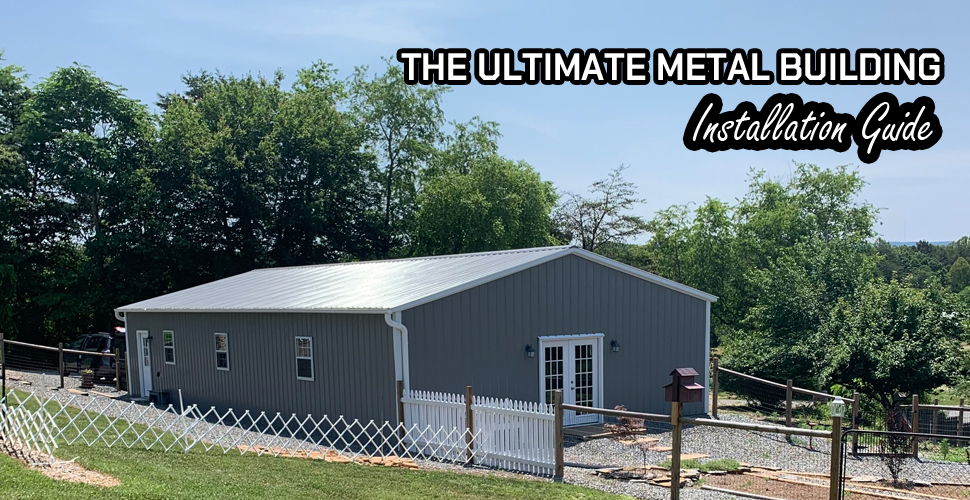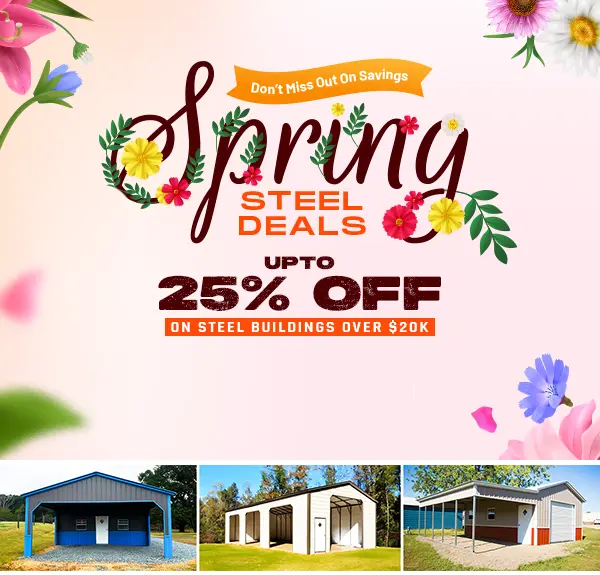
- April 4, 2024
- Metal Buildings
- Carports Advisor
The Ultimate Metal Building Installation Guide
A well-designed structure and proper construction are essential to the steel building installation. Any structure needs a firm ground to stand on. That’s why foundation design is crucial. A poorly designed base can lead to structural instability. The building might get damaged due to seismic activities, high-speed wind, or heavy snow load. So, what to do? Let’s see how to proceed with the installation of steel structure step by step. We will begin with site preparation and then proceed with a detailed guide for metal building installation. Let’s get going.
Site Preparation
Before beginning any construction work, you need to file for a steel building permit. For this, follow the instructions below:
- Choose the design and size of the metal structure you want to install.
- Ensure your design complies with all local building and zoning laws.
- Get the blueprint from your metal builder.
- Now, submit this blueprint along with your details, construction site, lot location, and permit fee.
- Site preparation begins after you secure a permit from the local authority.
Once you get the permit, you can focus on the installation site. Generally, metal builders do not include the foundation in their quotes, so you will likely have to prepare it yourself. So, let’s see how to prepare the site for a steel building.
- First, clean the entire area and remove large rocks, plantations, or vegetation. For larger sites, prefer a site survey by a professional first.
- Make sure to mark all utility lines running beneath. You won’t want to hit any pipelines. To know about utility lines on your property, contact the local municipal office.
- You may need help from the site inspector to gauge soil quality. Additional filling may be needed to raise the soil level to ensure proper drainage.
- Then, continue leveling the site. Proper soil filling and compacting are crucial to building a steady structure.
- If no power lines are near your site, you may pay extra to bring electric and water connectivity.
What Is The Cost Of Site Preparation?
- Land surveys generally cost an average of $1,500 per acre.
- Steel building site prep will cost about $6 to $45 per square foot. Land with uneven or high terrain will cost more than the one with moderating even and light vegetation.
- For soil testing, costs can range from $700 to $1900.
Note: The foundation is based on building size, location, and quality of soil.
Types Of Steel Building Foundation Options
Four Types Of Steel Building Foundation Options Can Be Recommended For You. Here They Are:
1. Dirt and Gravel: This is cost-effective and considered for moderate climate zones. It can generally be found with steel carports, small metal sheds, or garages. Over time, it might generate trenches, so re-leveling is needed at regular intervals.
2. Asphalt won’t wash away like dirt and gravel. It is a secured foundation but not suitable for bearing heavy loads or larger construction projects.
3. Perimeter Base: The perimeter base supports the structure with a concrete pier. It is used in combination with another type of base. It supports 3000 to 4000 PSI and distributes the weight of small structures across piers without cracking the base.
4. Concrete Slab: It creates the floor and supports the steel frame. The slab is generally 4-6 inches thick but can be as thick as 8-12 inches for severe climates and heavy loads.
Note: Concrete slab can bear more load than any other type of foundation.
The base must be able to bear the load of the steel structure, its interior items, heavy snow loads, and high-speed wind without failing. If you are planning any future expansion, consider its load now. Make sure that anchor bolts firmly secure the frame to the foundation. They help transfer the natural forces from frame to base and stabilize the building.
The Steel Building Installation Guide
Now that we have completed the permit and the foundation is ready, let’s move on to the step-by-step steel building installation process.
Step #1 Concrete Sealant
It is a liquid solution that protects concrete slabs from damage like stains, salt attack, freeze, and abrasion. It enhances the slab’s durability and longevity. It comes in two types: one that penetrates the surface and binds concrete and another that creates a film over the top layer.
After your concrete slab is cured (~28 days), you can apply concrete sealant & allow it to dry before the installation begins.
Step #2 Base Rails
These are long, square, tube-like structures on which the weight of the building rests. They hold the weight of the legs, trusses, sheets, and other materials. Set the rails and measure from corner to corner. Ensure they are aligned properly to form a square or rectangle.
This will be the base of the steel structure. Now, you will need to secure it. How? Let’s proceed.
Step #3 Anchors
Concrete anchors are most suitable for installing a metal structure on a concrete slab. The size of the anchor will depend on the slab’s thickness. The anchor’s job is to reinforce the structure into the base. We highly suggest using anchors for every steel building as they give structural support.
The anchor is drilled directly from the base rail into the concrete base. The anchor then expands outwards, creating a strong grip.
Step #4 Trusses
The crew begins assembling trusses once the base rail is bolted into the foundation. Trusses are visible ceilings of the frame held by legs. One truss is assembled, and it is bolted into the legs.
Step #5 Legs
Legs are vertical steel columns attached to the base rail and support the roof’s frame and its panels. Legs are bolted into the trusses, then the leg is raised to insert into the connector sleeve that attaches the legs to the base rail.
Note: With location, local codes, and building size and design, the spacing between legs and no. of legs will vary.
Step #6 Purlins
Also known as a hat channel, a hat channel is a straight galvanized steel tube that runs from one gable end to the other and is placed perpendicular to trusses. It is bolted directly into the trusses. Hat channels are not used in horizontal roofing styles. Their job is to support the roof panels.
Note: You may also find roof bows in some metal structures. Generally, these are part of trusses. They are used to create roof framing and support hat channels, giving the building structural support.
Step #7 Braces
Bracing is used to provide stability and resist lateral loads. It is bolted between two roof bows at the center and a roof bow and leg, which are placed at a 45° angle. For a wider structure, braces are wielded into the trusses at the center.
Step #8 Frame Outs
Also known as Dutch frame-out, they provide openings for all accessories, primarily doors and windows. They support the space created after removing the legs for the door’s opening.
We move towards the door frames once the basic skeleton for pre-fabricated steel building installation is completed. Here, metal doors will be attached with the help of a metal clip or hydraulic, depending on the door’s type.
Step #9 Grits
These are square steel tubes placed parallel to base rails to support vertical metal wall panels. Their purpose is similar to that of purlins. They are bolted to the structure’s legs.
Step #10 Foam Gap Sealant
These are dense foam strips that seal metal panels. They are used at wall edges and roof corners to keep insects, dust, and debris out. They are meant to seal all openings. They are applied to the steel panels before securing them with the structure.
Step #11 Metal Panels
Start with installing panels on the roof and then to the sides of the metal structure. Once the roof panels are placed, enclose them with a ridge cap to prevent any leakage or insects from entering. A ridge cap is essential for the vertical roof.
Step #12 Accessories & Insulation
Place all windows, doors, vents, and other add-ons that you have decided at this stage. Once done, start installing insulation. It is best to ask a professional team, as precision is required here. Insulation helps reduce heat transfer and regular indoor temperature efficiently.
Step #13 Structural Trim
Trim gives the steel structure a finished look. It is generally used around openings and intersections. Some options are J-trim, L-trim, or corner trim. You will generally find trim around the edges of the roof metal panels.
And that was a brief discussion on the steel building installation guide. Let’s now address some common queries that people ask.
Commonly Asked Questions
Q. Can you install a steel building yourself?
A. Installing a steel building is much easier and faster if you know what you are doing. For complete novices, we suggest hiring a construction crew. Though simple, the installation of a steel structure needs precision. It must be done correctly so that the building lasts.
Q. How much does it cost to install a steel building yourself?
A. You will have to buy a metal building kit that will cost $15 to $25 per square foot. You can consider a budget of $5 to $10 per square foot for construction. Since you will be doing most of the jobs alone, labor costs will be nil. You must construct the foundation and install a kit, accessories, and insulation. Fiberglass insulators will cost $0.30 to $1.50 per square foot.
Q. What foundation is needed for a steel building?
A. There are three broad foundation choices: dirt & gravel, asphalt, and concrete. We recommend a concrete slab as the best choice as it is durable and can bear more load.
Q. How do you anchor a steel building to concrete?
A. Anchor bolts must be placed perpendicular to the foundation surface. This step is crucial because if anchor placement is slightly off, you must reinstall it. To reduce the chances of shifting, prefer an anchor of shape, J or L. The anchor will then be attached to the base rail.
DIY Vs. Professional Steel Building Installation
Most of you would think about saving some cash by DIY metal building installation. While this may seem like a good idea on the surface, let’s compare them using different parameters to see which one suits you the best.
| DIY Vs Professional Installation For Metal Buildings | |
| Cost | |
| DIY makes projects affordable to install. You will save around 5% when you decide to do it yourself. Most DIY metal structures come with the kit, and you can follow instructions and enjoy your project. | A professional crew will add to the cost but will complete the installation process perfectly. Most steel builders include shipping and installation in their final quote, so you won’t be saving much. The installation of a metal structure must be precise, or else it might fail to withstand even a mild gust of wind. |
| Size | |
| It will be a long project, so for construction enthusiasts, it is a type of project that they will thoroughly enjoy. | Larger buildings will take more time to complete. A professional team might be able to do it within a few days, compared to DIYers who will spend over a month. |
| Complexity | |
| Complex buildings may lead to trouble for DIY enthusiasts as intricate details must be completed precisely. Extra hands will be needed to handle large, bulky materials like trusses. | A professional team is well-experienced and trained to deal with any type of design intricacy and complex building. They can easily carry out tasks and install steel structures that retain structural strength with time. |
| Time & Effort | |
| DIY metal building projects will consume more time and take more effort. | The team will put all the time and effort together, so you don’t have to worry. |
So, What Should You Opt For Between DIY Vs Professional Installation?
If you have little construction experience, you can DIY small structures such as metal sheds, garden sheds, or carports. However, it is best to ask for professional help for large and complex buildings.
Tools & Equipment Used For Installation Of Metal Building
Before gathering metal building installation components, it is important to prepare for safety. We recommend a personal protection kit for your safety. Here is the list of tools that you will need:
Things Needed For Foundation Construction
- Measuring tape, string, & wheelbarrow
- Cement premix
- Clean water
- Gravel for drainage
- Concrete form (temporary mold)
- Shovel, Trowel, & spirit level
Types Of Anchor Used In The Installation Of Steel Structures Are:
- Rebar anchors (generally used in anchoring a carport)
- Auger anchors
- Concrete anchors
- Concrete wedge anchors
- Asphalt anchors
Tools & Equipment Needed For Steel Building Installation
| Chalk lines Channel locks Cordless drills and bits Caulking guns Different types of wrenches (crescent, socket, power, pipe, etc.) Hacksaws Pliers | Tape measure & plumb bob (to establish vertical line) Utility knives Vice grips Wire brush Metal cutter Ladders Tarps (to create shade) |
Lastly, you will need telescopic lifts, man lifts, scissor lifts, cranes, and telehandlers for large metal building installation.
State & Local Regulations
Steel building permits are essential to ensure the safety of inhabitants and the local neighborhood. You must secure this permit before starting any construction work. The permit fee is based on the type and size of the project and varies across rural areas, suburbs, cities, and states.
To learn more about the steel building permitting process, visit your local authority’s website or office. The local steel building regulations and zoning requirements for steel buildings will largely depend on the area and locality. For instance, an area prone to high-speed winds or heavy snowfalls will require a concrete base, additional anchors & braces, and 12-gauge durable steel framing.
If you don’t have building permits for steel structures, you may face a fine or penalty from the local department. Note that the permit process generally takes 1 to 2 months.
Common Challenges & Its Solutions
Here are some typical problems that can arise during steel building installation:
- Noise & vibration due to bolting & drilling
- Corrosion due to external weather conditions such as condensation
- Fatigue, cracks, or buckling due to manufacturing error
- Hazardous operations like welding, painting, or cutting metal frames or sheets.
- Installation of steel structure comes with a high initial cost.
Want Steel Building With Excellent Craftsmanship?
Steel building installation processes and methods vary between contractors. But when your metal structure is installed correctly, it will retain its structural strength and longevity with time. Check out Carports Advisor’s website for steel building designs, or create your own using our 3D design tool. Call us at (336)-914-1654 to find out more!

